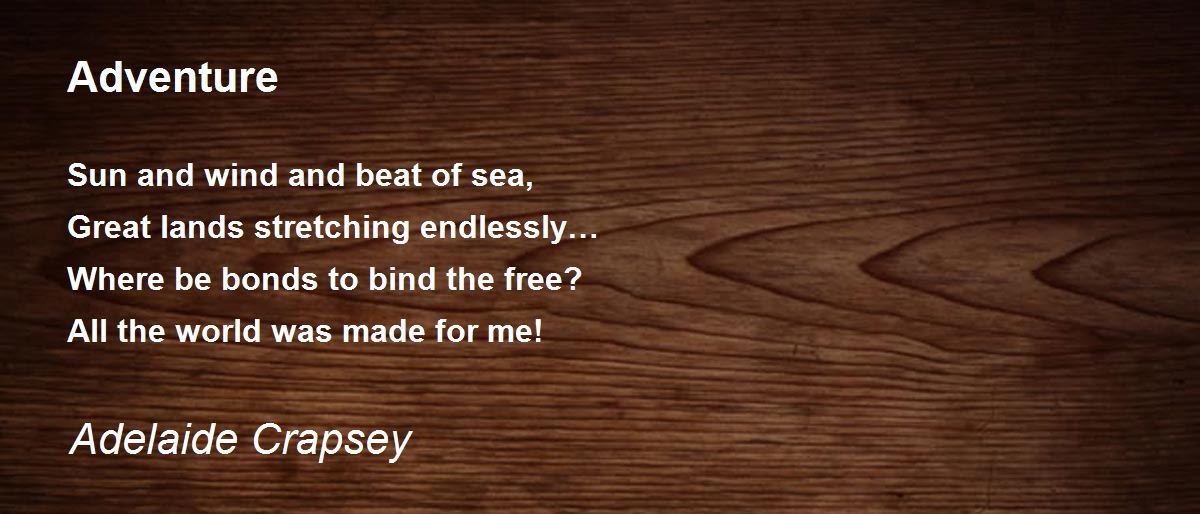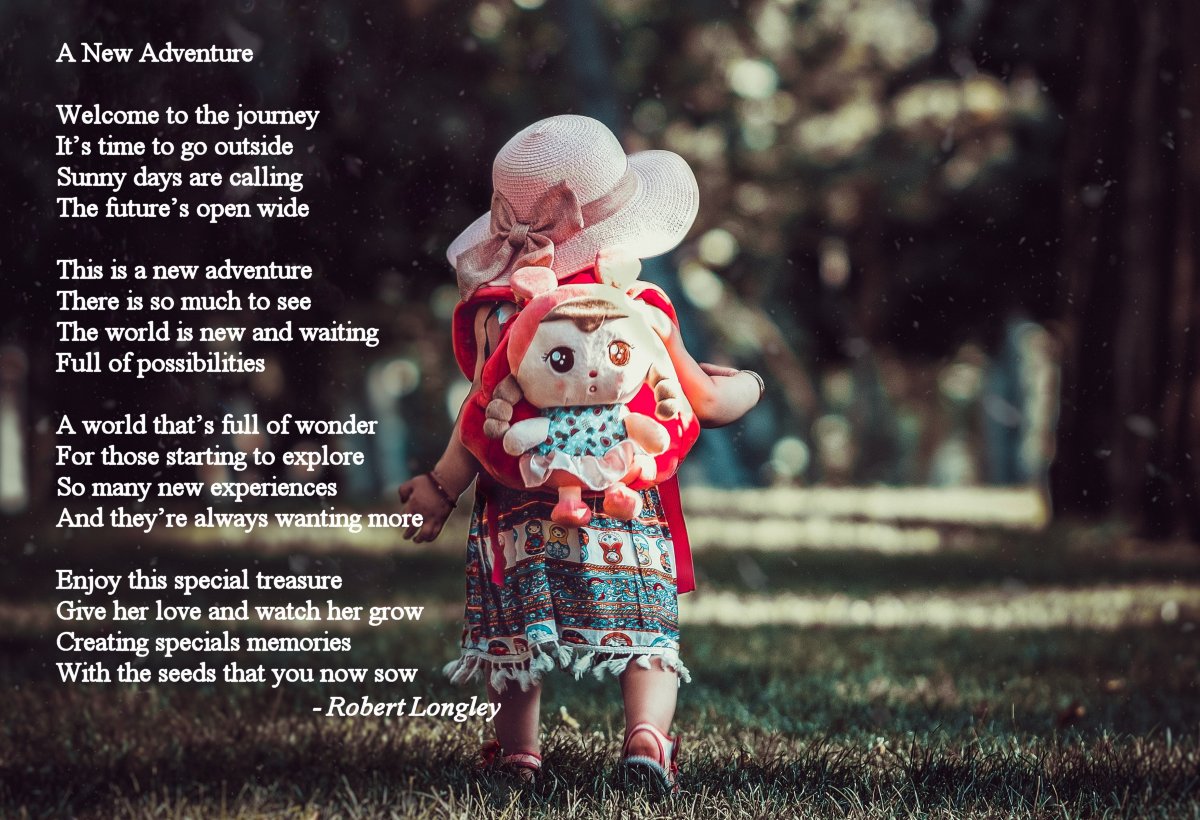Poem for adventure, an enchanting literary genre, beckons readers into a realm of exhilarating escapades, captivating them with its vivid imagery and profound themes. This enthralling narrative explores the essence of adventure poetry, tracing its historical roots, dissecting its elements, and showcasing its enduring impact on literature and beyond.
From the rugged landscapes of William Wordsworth to the introspective journeys of modern poets, adventure poetry continues to inspire and captivate audiences with its timeless allure.
Introduction
Adventure poetry is a genre of poetry that celebrates the excitement and challenges of exploring the unknown. It often features themes of courage, determination, and the pursuit of new experiences.
Characteristics of adventure poetry include:
- A focus on action and adventure:Adventure poetry often tells stories of daring feats and dangerous journeys.
- A celebration of nature:Adventure poetry often celebrates the beauty and power of the natural world.
- A use of vivid language:Adventure poetry often uses vivid language to create a sense of excitement and danger.
Historical Significance
Adventure poetry has a long and storied history. Some of the earliest examples of adventure poetry can be found in the epic poems of Homer and Virgil. In the Middle Ages, adventure poetry was often used to celebrate the deeds of knights and warriors.
During the Renaissance, adventure poetry became more focused on the exploration of new worlds.
Elements of Adventure Poetry

Adventure poetry, as its name suggests, captures the essence of daring escapades and thrilling experiences. It employs a range of literary devices to evoke the excitement and challenges of adventure, including vivid imagery, the portrayal of nature as a force, and the depiction of human resilience.
Vivid Imagery
Adventure poetry relies heavily on vivid imagery to transport readers into the heart of the action. Poets use sensory language to create a multi-dimensional experience, engaging the reader’s sight, sound, touch, smell, and taste. By painting vivid pictures with words, poets immerse readers in the adventure, making them feel as if they are part of the journey.
- Example:In William Wordsworth’s “Composed upon Westminster Bridge, September 3, 1802,” the poet describes the “mighty heart” of London, using vivid imagery to capture the grandeur and energy of the city.
Nature as a Force
In adventure poetry, nature is often portrayed as a force to be reckoned with. It can be a source of beauty and wonder, but also a formidable obstacle that tests the limits of human endurance. Poets use nature to symbolize the challenges and rewards of adventure, and to explore the relationship between humanity and the natural world.
- Example:In Samuel Taylor Coleridge’s “The Rime of the Ancient Mariner,” the mariner’s journey is marked by encounters with supernatural forces and treacherous seas, reflecting the challenges and dangers of adventure.
Human Resilience
Adventure poetry often celebrates human resilience and the ability to overcome adversity. Poets explore the strength of the human spirit and the indomitable will to persevere in the face of challenges. Adventure poetry inspires readers to embrace their own adventurous spirit and to strive for greatness.
- Example:In Alfred, Lord Tennyson’s “Ulysses,” the titular character embodies the spirit of adventure and resilience, as he embarks on a final voyage to “sail beyond the sunset.”
Themes in Adventure Poetry
Adventure poetry often explores themes that resonate with the human spirit’s desire for exploration, challenge, and self-discovery. These themes provide a framework for understanding the experiences and emotions encountered on an adventurous journey.
Theme of Exploration
Exploration is a central theme in adventure poetry. It represents the desire to venture into the unknown, to push boundaries, and to discover new experiences. Through vivid imagery and descriptive language, poets capture the thrill of setting out on a journey, embracing the uncertainty and anticipation that lie ahead.
The act of exploration not only involves physical adventures but also intellectual and emotional quests. Adventure poetry explores the ways in which individuals embark on journeys of self-discovery, seeking to understand their own capabilities, values, and place in the world.
Notable Adventure Poets

Adventure poetry has been a staple of English literature for centuries, with poets from William Wordsworth to Samuel Taylor Coleridge penning iconic works that capture the thrill and excitement of exploration. These poets have inspired generations of readers with their vivid descriptions of nature, their exploration of human emotion, and their celebration of the human spirit.
William Wordsworth
William Wordsworth (1770-1850) is widely regarded as one of the greatest poets of the Romantic era. His work is characterized by its celebration of nature, its exploration of the human condition, and its use of simple, yet evocative language.
- Tintern Abbey(1798): This poem reflects on the poet’s return to a place of natural beauty, and explores the themes of memory, nature, and the human experience.
- Ode: Intimations of Immortality(1807): This poem explores the poet’s sense of loss and longing for a time when he felt a closer connection to nature.
- The Prelude(1850): This autobiographical poem tells the story of the poet’s life and his journey to becoming a poet.
Samuel Taylor Coleridge
Samuel Taylor Coleridge (1772-1834) was a contemporary of William Wordsworth and a fellow member of the Romantic movement. His work is characterized by its use of imagination, its exploration of the supernatural, and its use of vivid and evocative language.
- The Rime of the Ancient Mariner(1798): This long narrative poem tells the story of a sailor who is cursed after killing an albatross.
- Kubla Khan(1816): This poem is a fragment of a larger work, and it describes a vision of a magnificent palace and its surrounding landscape.
- Christabel(1816): This unfinished poem tells the story of a young woman who is kidnapped by a witch.
The influence of William Wordsworth and Samuel Taylor Coleridge on adventure poetry cannot be overstated. Their work helped to define the genre and to inspire generations of poets to come.
Modern Adventure Poetry
Modern adventure poetry emerged in the 20th century, reflecting the changing societal and technological landscapes. It continues the tradition of celebrating exploration, discovery, and the human spirit while incorporating new perspectives and techniques.
Evolution of Adventure Poetry
Adventure poetry evolved from its traditional focus on physical exploration to encompass a broader range of human experiences. It now explores themes of personal growth, self-discovery, and the search for meaning in modern life.
Contemporary Adventure Poets
- Wendell Berry: Known for his poems that celebrate the rural landscape and the importance of community.
- Gary Snyder: Explores themes of nature, ecology, and the interconnectedness of all living beings.
- Adrienne Rich: Her poetry delves into the experiences of women and marginalized groups, challenging societal norms.
New Techniques, Poem for adventure
Modern adventure poetry employs a variety of innovative techniques, including:
- Free verse: Breaking away from traditional poetic forms allows poets to express their ideas more freely.
- Collage: Combining different elements, such as text, images, and sound, to create a multi-sensory experience.
li> Intertextuality: Referencing other works of literature or art to create a dialogue with the past.
Adventure Poetry in Other Media: Poem For Adventure
Adventure poetry transcends the written word, finding expression in various artistic mediums.
Adventure Poetry in Films
Films often incorporate adventure poems to enhance storytelling and evoke emotions. For instance, “The Charge of the Light Brigade” by Alfred, Lord Tennyson, was used in the 1968 film of the same name to capture the heroism and tragedy of war.
Adventure Poems Set to Music
Adventure poems have inspired countless musical compositions. One notable example is “The Highwayman” by Alfred Noyes, set to music by the folk-rock band The Highwaymen. The song’s haunting melody and vivid imagery transport listeners to the world of the poem.
Impact on Other Art Forms
Adventure poetry has influenced other art forms, including painting and sculpture. The epic journeys and heroic deeds depicted in poems have inspired artists to create works that embody the spirit of adventure. For instance, the painting “The Starry Night” by Vincent van Gogh evokes the vastness and mystery of the night sky, a theme often explored in adventure poetry.
Creating Your Own Adventure Poem
Crafting an adventure poem is an exciting endeavor that allows you to express your imagination and evoke a sense of wonder in readers. Follow these steps to embark on this poetic journey:
1. -*Find Inspiration: Draw inspiration from personal experiences, nature, books, or films that evoke a sense of adventure. Let your imagination roam free and capture the essence of what excites you.
2. -*Choose a Theme: Consider the central idea or emotion you want to convey. Adventure poems often explore themes of exploration, discovery, risk-taking, and overcoming challenges.
3. -*Develop a Narrative Arc: Craft a compelling narrative with a clear beginning, rising action, climax, falling action, and resolution. Use vivid imagery and sensory details to transport readers into the heart of the adventure.
4. -*Use Sensory Details: Engage all five senses to create a rich and immersive experience for readers. Describe sights, sounds, smells, tastes, and textures to bring the adventure to life.
5. -*Experiment with Language: Use figurative language, such as metaphors, similes, and personification, to create vivid imagery and evoke emotions. Experiment with rhythm, rhyme, and sound devices to enhance the musicality of your poem.
6. -*Revise and Refine: Once you have a draft, take time to revise and refine it. Read your poem aloud to identify areas that need improvement. Seek feedback from trusted sources to gain valuable insights.
Remember, the most important element in writing an adventure poem is to capture the spirit of adventure and share it with your readers. Let your imagination soar and create a poem that transports them to a world of wonder and excitement.
Summary
In conclusion, adventure poetry stands as a testament to the indomitable spirit of exploration, resilience, and self-discovery. Through its evocative language and timeless themes, it continues to transport readers to extraordinary realms, leaving an enduring legacy that transcends the boundaries of time.
Commonly Asked Questions
What is the defining characteristic of adventure poetry?
Adventure poetry is characterized by its vivid imagery, portrayal of nature as a force, and exploration of themes such as exploration, overcoming obstacles, and self-discovery.
Who are some notable adventure poets?
William Wordsworth, Samuel Taylor Coleridge, and Walt Whitman are among the most renowned adventure poets.
How has adventure poetry evolved in modern times?
Modern adventure poetry incorporates contemporary themes and techniques, reflecting the changing nature of exploration and the human experience.